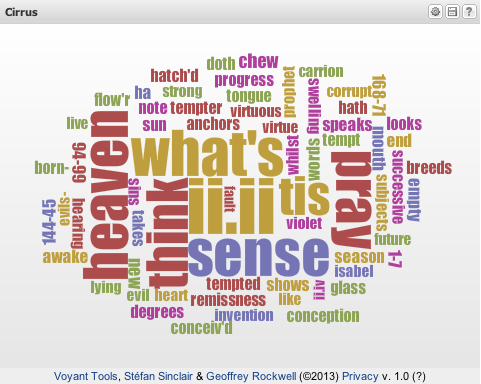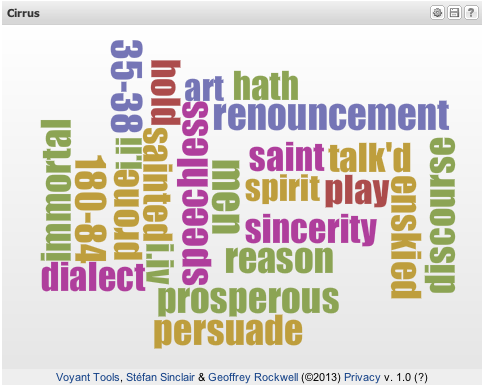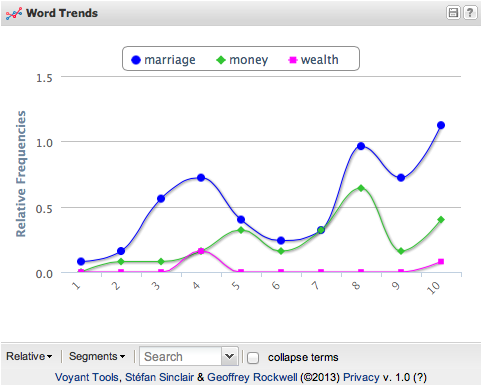Overview
Voyant Tools offers an online environment for text analysis. Uses for its growing suite of tools include tracking word frequency, word collocation, and visualizing trends in texts both large and small (charting instances of diction, repeated concepts, characters, etc.). Voyant can be used to prompt close reading, track trends across one or multiple novels, and visualize trends in student writing.
Documentation
Voyant works with a range of file types, including plain text, RTF, XML, PDF, and .doc and .docx files (among others). Choose the tools you would like to work with and input text either by uploading files or copy-and-pasting.
Detailed instructions are included with the Voyant Tools documentation and screencast tutorials.
Suggested Activities
Essay revision with automated textual analysis
This exercise asks students to visualize and examine trends in their writing using Voyant. By visualizing their writing, students may examine key trends in their paper, determine whether commonly used words relate to their thesis, discover writing ticks, and develop systematic strategies for revising their paper.
View the assignment by Michael Widner via UT Austin’s Digital Writing & Research Lab.
Building word clouds to generate search terms
Jeffrey Boruszak’s exercise helps student generate an overview of their research topic by visualizing collected sources in Voyant. Ask students to generate a Voyant visualization using primary and secondary research sources; students may then discover meaningful topics and trends in their research as they move toward a topic. Additionally, students can use this exercise to generate new search terms as they continue to refine and build a corpus of research materials.
View the assignment by Jeffrey Boruszak via UT Austin’s Digital Writing & Research Lab.
Voyant in Teaching
Voyant Tools documentation comes with an extensive list of pedagogical resources for Voyant, including course work, critical approaches to teaching, and course syllabuses. Scroll through the examples gallery at Voyant Tools Documentation to view these extensive resources.
View the examples gallery at Voyant Tools
Close reading at scale
Use the cirrus word cloud generator to visualize two or more related scenes for close reading. Ask students first to identify word trends or patterns within each visualization and then to construct arguments that connect the similarities or differences between the two visualizations. Each visualization can draw from one passage or combine a number of related passages.
Example
This example deals with Shakespeare’s “Measure for Measure.” Collect different passages that describe Angelo and Isabella, then visualize each collection of text as a word cloud. Ask students to consider what words are similar within each visualization and what the related words suggest about the characterization of Isabella and Angelo, respectively. Then ask students to compare the two characterizations by reading across both visualizations.
Angelo’s passions (embodied)

Isabella’s virtue (enskied)

Tracking concepts across text(s)
Use the Bubblelines or Corpus Term Frequencies to identify related keywords, concepts, or characters across one or multiple works. Present the class with one or two visualizations that suggests a relationship; ask students to argue for or against the trend and support their positions with evidence from the text (discoverable using the keywords in context window).
Example
Visualize word trends in Jane Austen’s Pride and Prejudice to compare the relationship between money, marriage, and wealth. Is there a relationship between marriage and money in the novel. If so, what evidence exists to characterize it? Why does wealth deviate from the observed trend? Is there a reason why references to wealth only occur at certain points in the novel?

Viewing trends in student writing
Use text analysis to visualize trends in student writing. Do certain patterns emerge across student work that the class can reflect upon? Voyant Tools can be used to present common points of difficulty in assignments and offer an engaging interface for students to examine their writing habits.
back